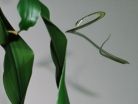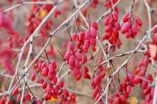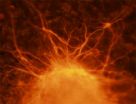(Press-News.org) WASHINGTON D.C. Mar. 4, 2014 -- Animal flight behavior is an exciting frontier for engineers to both apply knowledge of aerodynamics and to learn from nature's solutions to operating in the air. Flying snakes are particularly intriguing to researchers because they lack wings or any other features that remotely resemble flight apparatus.
Before you envision flying snakes raining down from the sky, the ones involved in this study are small -- about 1 meter in length and the width of your thumb -- and live in the lowland tropical forests of Asia and Southeast Asia.
Virginia Tech Assistant Professor Jake Socha, renowned for his work with flying snakes, recently teamed with Boston University and George Washington University researchers to explore snakes' lift and wakes using computer simulations. They describe their work in the journal Physics of Fluids.
Previously, experiments in a wind tunnel had returned an unexpected finding: the snake's shape is not only good at generating a force of lift, but it also gets an extra boost of lift when facing the air flow at a certain angle.
"After experiments uncovered this, we decided to use computer simulations to try to explain it," says Lorena Barba, associate professor of mechanical and aerospace engineering at the George Washington University.
So much of the aerodynamics of animal flight -- especially that of flying snakes -- remain a mystery. Scale is important, but also the manner in which flight is achieved.
"Rather than fixed wings, animal fliers have flapping wings," explains Barba. "In the case of gliders, their small scale means they're always in a flurry of whirling winds. By understanding how they can be graceful and efficient under these conditions, we can in turn use that knowledge to create small flying machines that are equally graceful."
Whirls of wind can be particularly useful: these little vortices "can give flying snakes an extra lift," notes Barba. "The shape of the snakes in flight -- which is a flattened version of its shape at rest -- gets help from little vortices around it."
Next, the researchers would like to include more elements of the snake's real gliding conditions into their computer simulations, such as its full body forming an S-shape, rather than working with just a section.
"This will be more difficult to do in a computer model, but it will probably reveal more about the complicated flow patterns snakes take advantage of to be such gifted gliders," Barba says.
INFORMATION:
The article, "Lift and wakes of flying snakes" (DOI: 10.1063/1. 4866444) is authored by Anush Krishnan, John J. Socha, Pavlos P. Vlachos, L. A. Barba. It will be published in the journal Physics of Fluids on on March 4, 2014. After that date, it may be accessed at: http://scitation.aip.org/content/aip/journal/pof2/26/3/10.1063/1.4866444?
ABOUT THE JOURNAL
Physics of Fluids is devoted to the publication of original theoretical, computational, and experimental contributions to the dynamics of gases, liquids, and complex or multiphase fluids. See: http://pof.aip.org
What makes flying snakes such gifted gliders?
A team of researchers exploring the aerodynamics of flying snakes finds that whirls of wind, the little vortices surrounding it, give them an extra lift
2014-03-05
ELSE PRESS RELEASES FROM THIS DATE:
Meat and cheese may be as bad for you as smoking
2014-03-05
MARCH 4, 2014 — That chicken wing you're eating could be as deadly as a cigarette. In a new study that tracked a large sample of adults for nearly two decades, researchers have found that eating a diet rich in animal proteins during middle age makes you four times more likely to die of cancer than someone with a low-protein diet — a mortality risk factor comparable to smoking.
"There's a misconception that because we all eat, understanding nutrition is simple. But the question is not whether a certain diet allows you to do well for three days, but can it help you survive ...
Cultural world heritage threatened by climate change
2014-03-05
From the Statue of Liberty in New York to the Tower of London or the Sydney Opera House -- sea-level rise not only affects settlement areas for large parts of the world population but also numerous sites of the UNESCO World Heritage. This is shown in a new study by Ben Marzeion from the University of Innsbruck and Anders Levermann from the Potsdam Institute for Climate Impact Research.
"The physical processes behind the global rise of the oceans are gradual, but they will continue for a very long time," says climate scientist Ben Marzeion. "This will also impact the cultural ...
Sea-level rise threatens UNESCO World Heritage sites
2014-03-05
Some of the world's most recognisable and important landmarks could be lost to rising sea-levels if current global warming trends are maintained over the next two millennia.
This is according to a new study, published today, 5 March, in IOP Publishing's journal Environmental Research Letters, that has calculated the temperature increases at which the 720 sites currently on the list of UNESCO World Heritage sites would be impacted by subsequent sea-level rises.
The Statue of Liberty, Independence Hall, Tower of London and Sydney Opera House are among the 136 sites that ...
Passive smoking causes irreversible damage to children's arteries
2014-03-05
Exposure to passive smoking in childhood causes irreversible damage to the structure of children's arteries, according to a study published online today (Wednesday) in the European Heart Journal [1].
The thickening of the arteries' walls associated with being exposed to parents' smoke, means that these children will be at greater risk of heart attacks and strokes in later life. The researchers from Tasmania, Australia and Finland say that exposure to both parents smoking in childhood adds an extra 3.3 years to the age of blood vessels when the children reach adulthood.
The ...
Lower index to ring finger ration associated with higher risk of osteoarthritis in knee
2014-03-05
A new study published online today in the journal Rheumatology has found that the lower the ratio between a person's index finger (2D) and their ring finger (4D), the higher their risk of developing severe osteoarthritis in their knees, requiring a total knee replacement.
Osteoarthritis (OA) is a major public health problem linked with significant disability in knees and hips. Hormonal factors are thought to play a role, which is thought to account for the well documented difference in prevalence of OA between men and women. Anthropological studies have suggested that ...
Are plants more intelligent than we assumed?
2014-03-05
This news release is available in German.
Leipzig. Plants are also able to make complex decisions. At least this is what scientists from the Helmholtz Center for Environmental Research (UFZ) and the University of Göttingen have concluded from their investigations on Barberry (Berberis vulgaris), which is able to abort its own seeds to prevent parasite infestation. The results are the first ecological evidence of complex behaviour in plants. They indicate that this species has a structural memory, is able to differentiate between inner and outer conditions as well ...
Hot on the trail of cellular metabolism
2014-03-05
UCPs or uncoupling proteins are present in mitochondria, the powerhouse of each cell in the body. The functions of most of the five known UCPs remain mysterious (UCP2-UCP5), whereby only the distinct function for UCP1 has thus far been discovered. UCP1 is responsible for heat production when muscle activity is deficient such as is the case with babies and animals in hibernation. The research team at the Department of Physiology and Biophysics at the University of Veterinary Medicine in Vienna were able to provide a fundamental explanatory concept for the function of UCP2 ...
Study shows nearly fivefold increased risk for heart attack after angry outburst
2014-03-05
BOSTON – Call it what you will – getting red in the face, hot under the collar, losing your cool, blowing your top – we all experience anger. And while we know that anger is a normal, sometimes even beneficial emotion, we're also aware of the often harmful connection between anger and health. New research from Beth Israel Deaconess Medical shows an even more compelling reason to think about getting anger in check – a nearly fivefold increase in risk for heart attack in the two hours following outbursts of anger.
"There has been a lot of research on anger; we already ...
Not even freezing cold stops alien species in high altitudes
2014-03-05
They hitchhike with us under the soles of our shoes and muddy car tires. Harsh and cold climates do not seem to stop alien plants from establishing themselves in high altitudes, where they now successfully penetrate the alpine vegetation, according to a study at Umeå University in Sweden and the University of Antwerp, Netherlands.
"Alien plants often gain advantages in their new environment because they lack natural enemies, and in this case the lack of strong competitors amongst alpine plants may be the key to success for generalist native species," says ecologist Ann ...
Horses set to gain health benefits from stem cell advance
2014-03-05
Horses suffering from neurological conditions similar to those that affect humans could be helped by a breakthrough from stem cell scientists.
Researchers who are the first to create working nerve cells from horse stem cells say the advance may pave the way for cell therapies that target conditions similar to motor neurone disease.
The research could also benefit horses affected by grass sickness, a neurological condition that affects around 600 horses a year in the UK.
Little is known about the disease, which causes nerve damage throughout the body. It is untreatable ...
LAST 30 PRESS RELEASES:
Why nail-biting, procrastination and other self-sabotaging behaviors are rooted in survival instincts
Regional variations in mechanical properties of porcine leptomeninges
Artificial empathy in therapy and healthcare: advancements in interpersonal interaction technologies
Why some brains switch gears more efficiently than others
UVA’s Jundong Li wins ICDM’S 2025 Tao Li Award for data mining, machine learning
UVA’s low-power, high-performance computer power player Mircea Stan earns National Academy of Inventors fellowship
Not playing by the rules: USU researcher explores filamentous algae dynamics in rivers
Do our body clocks influence our risk of dementia?
Anthropologists offer new evidence of bipedalism in long-debated fossil discovery
Safer receipt paper from wood
Dosage-sensitive genes suggest no whole-genome duplications in ancestral angiosperm
First ancient human herpesvirus genomes document their deep history with humans
Why Some Bacteria Survive Antibiotics and How to Stop Them - New study reveals that bacteria can survive antibiotic treatment through two fundamentally different “shutdown modes”
UCLA study links scar healing to dangerous placenta condition
CHANGE-seq-BE finds off-target changes in the genome from base editors
The Journal of Nuclear Medicine Ahead-of-Print Tip Sheet: January 2, 2026
Delayed or absent first dose of measles, mumps, and rubella vaccination
Trends in US preterm birth rates by household income and race and ethnicity
Study identifies potential biomarker linked to progression and brain inflammation in multiple sclerosis
Many mothers in Norway do not show up for postnatal check-ups
Researchers want to find out why quick clay is so unstable
Superradiant spins show teamwork at the quantum scale
Cleveland Clinic Research links tumor bacteria to immunotherapy resistance in head and neck cancer
First Editorial of 2026: Resisting AI slop
Joint ground- and space-based observations reveal Saturn-mass rogue planet
Inheritable genetic variant offers protection against blood cancer risk and progression
Pigs settled Pacific islands alongside early human voyagers
A Coral reef’s daily pulse reshapes microbes in surrounding waters
EAST Tokamak experiments exceed plasma density limit, offering new approach to fusion ignition
Groundbreaking discovery reveals Africa’s oldest cremation pyre and complex ritual practices
[Press-News.org] What makes flying snakes such gifted gliders?A team of researchers exploring the aerodynamics of flying snakes finds that whirls of wind, the little vortices surrounding it, give them an extra lift




